Worth reading
The section contains brief answers to questions most frequently asked by patients (e.g., what is the difference between a radiographic and fluoroscopy examination), information about novel equipment and technologies, interesting but generally unknown facts as well as a subsection covering miscellaneous issues. Below you will find selected excerpts from this section.
Painting of Saint Michael Archangel, patron of radiologists
On 29 September 2019, an painting of Saint Michael Archangel, the patron of radiologists, was consecrated at the Church of the Immaculate Conception of the Blessed Virgin Mary (19 Kopernika Street) in Kraków. The painting, which was installed in one of the altars, was funded by Polradiologia Viva.
The location for the painting was not selected at random, as this church is part of the former University Hospital complex. The building adjacent to the church had housed the Radiology Laboratory since the 1920s, and the Chair of Radiology, at Collegium Medicum, Jagiellonian University since 1951. Both units were moved to their new locations on 1 January 2023.

Plaques commemorating the beginnings of Polish radiology
The history of Polish Radiology started in January 1896. The first X-ray pictures in our country were taken by Professor of the Jagiellonian University, Karol Olszewski. The fact took place between 8 and 20 January and the pioneering research was reported in the Kraków newspaper Czas, on 21 January 1896. The first Polish radiological examinations are commemorated by two plaques.
On 1 June 2016, during the 41st Congress of the Polish Medical Society of Radiology held in Kraków, a plaque was unveiled on the wall of the building (today Wróblewski Collegium, at No. 2 Olszewskiego Street), where Professor Olszewski took the historical X-rays.
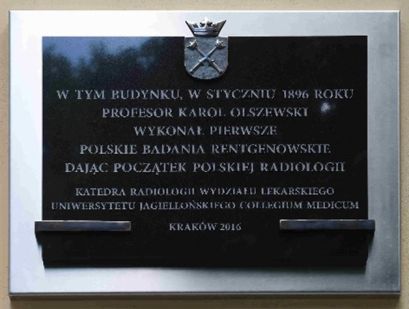
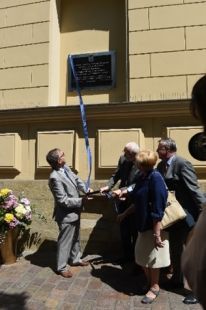
On 21 January 2021, a plaque commemorating 125 years of Polish Radiology was unveiled in Broniszów, the village in which Karol Olszewski was born.
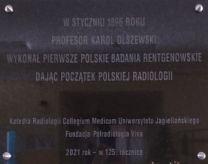

The two plaques were set up following the initiative of Prof. Andrzej Urbanik, Head of the Chair of Radiology at Collegium Medicum, Jagiellonian University, and President of Polradiologia Viva foundation.
A tree planted to commemorate 125th anniversary of Polish Radiology
125th anniversary of Polish Radiology was celebrated in 2021. The most important jubilee related event was the exhibition held in Kraków, where the first Polish X-rays were taken just a few days after Roentgen's discovery had been announced. During the opening ceremony, Professor Andrzej Urbanik, who came up with the concept of the event, suggested that a jubilee tree should be planted in the heart of Kraków, in the City Park surrounding the Old Town. The idea was supported by the local authorities. The event of planting the tree was scheduled to be held in 2022 during the Symposium of the International Society for History of Radiology (ISHRAD). Hence, one year after the idea was brought forth, on 7 October 2022, a Norway maple was planted to commemorate 125th anniversary of Polish Radiology. Those participating in the ceremony included i Arpan Banerjee (Chairman of ISHRAD), Uwe Busch (Director of German Röntgen Museum in R.), Renaat Van den Broeck (Curator of the Belgian Museum of Radiology), Mats Geijer (member of the ISHRAD Board), Jacek Skłądzień (representative of Collegium Medicum Jagiellonian University and Krakow Medical Society), Michał Chlipała (Chair of History of Medicine at Jagiellonian University), Jolanta Chodor (Medical Chamber in Krakow), as well as Andrzej Urbanik and Tadeusz Popiela (Chair of Radiology, Collegium Medicum Jagiellonian University).

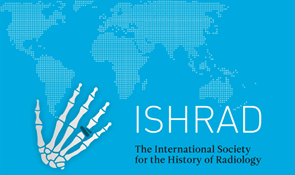
Symposium of the International Society for History of Radiology in Poland
On 7-8 October 2022, Krakow hosted the Symposium of the International Society for the History of Radiology (ISHRAD). The event was organised by Departments of Radiology and History of Medicine, Collegium Medicum of the Jagiellonian University, as well as Polradiologia Viva Foundation. The event was held under the honorary patronage of Prof. Jacek Majchrowski – Mayor of Krakow, Prof. Jacek Popiel – Rector of the Jagiellonian University, and Prof. Tomasz Grodzicki – Deputy Rector of the Jagiellonian University in charge of Collegium Medicum. The partners included the Regional Chamber of Medicine in Krakow, and Krakow Medical Society.
The 2022 ISHRAD Symposium was a hybrid event – sixty participants were present on site in the beautiful auditorium of Theatrum Anatomicum, while more viewers followed the proceedings online. Three sessions took place on 8 October. The first one focused exclusively on the history of Polish radiology, the second covered selected topics related to the history of diagnostic imaging in the world, and the third session included presentations of non-medical applications of radiology. Speakers from five countries presented a total of 22 fascinating papers.
Most importantly the event provided an opportunity for presenting historical achievements of radiology in Poland (including Krakow), which virtually had been unknown internationally. The guests from abroad were captivated by Krakow basking in the autumn sun, and they were greatly impressed with the collections of the Museum of Pharmacy and Anatomy which they visited on this occasion. At the beginning the guests had a surprise - on 7 October they attended a ceremony of planting a maple tree in the City Park, intended to commemorate 125th anniversary of Polish radiology which in fact was born in Krakow.
Report from the Symposium: https://www.auntminnieeurope.com/index.aspx?sec=sup&sub=mol&pag=dis&ItemID=623382
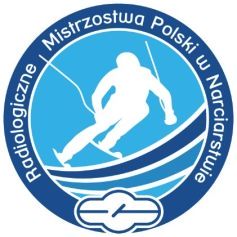
Polish Radiology Ski Championships
The idea for the event was brought forth by radiologists Dr. Ewa Górka from Zakopane and Prof. Andrzej Urbanik from Kraków. The first championships were held in 2005. For 10 years the event was organized by the Chair of Radiology at Collegium Medicum, Jagiellonian University. Subsequently, the Unit for Diagnostics in Sports Medicine, created within the Polish Medical Society of Radiology, was designated to take over the organisation of the event. The Championships are open to all those affiliated with the community of radiologists as well as their families.
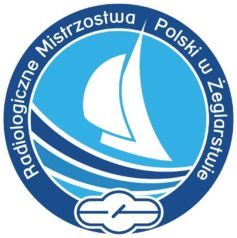
Polish Radiology Sailing Championships
Polish Radiologists Championships in Sailing, organized since 2010, were initiated by Prof. Andrzej Urbanik from Kraków. The regatta is open to crews representing specific regional branches of the Polish Medical Society of Radiology. The competing crews may include radiologists, radiographers as well as specialists in medical physics or engineering working in radiology industry. As a rule the Championships are held in the same years as the congresses of the Society. However, the regatta can also take place in the subsequent years, if at least two crews from other branches are willing to challenge the former winner and wish to organize the event.
The regatta has mainly been organised by the Chair of Radiology at Collegium Medicum, Jagiellonian University, and since 2013 the event has been co-organized by the Department of Radiology, Medical University of Gdańsk.

Running events for radiologists
An event for those into running was an idea conceived by Dr. Wojciech Wawrzynek from Silesia. It was organised for the first time in 2016, during the 41st Congress of the Polish Medical Society of Radiology (PLTR) in Kraków. On that occasion it was a big success, so the event has regularly been included in the program of the PLTR Congresses. The event is open to those attending a given Congress.
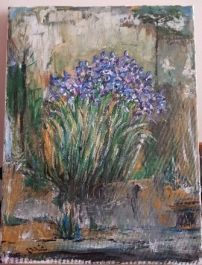
RadioArt Exhibition
The event is intended to display works of art created by radiologists. This is not a competition, but rather a meeting of those who, on a daily basis, create images using electromagnetic radiation. The event was proposed by Prof. Andrzej Urbanik from Kraków, and was for the first time organised in 2016, during the 41st Congress of the Polish Medical Society of Radiology (PLTR) in Kraków. It was a great success, and as a result this artistic tradition is to be continued.
Spiritual retreats for radiologists
The annual retreats intended for members of our community were initiated in 2011, by Dr. Tomasz Legaszewski from Silesia. The motto adopted for the event says "too busy not to pray". Those interested meet once a year in September, in Kamień Śląski. This is where Jacek Odrowąż, known as Saint Hyacinth of Poland, was born in 1183. The palace located at the site of his birth comprises a chapel and sanctuary dedicated to him.


International Day of Radiology (IDoR)
It is held each year on 8 November, the day when Wilhelm Conrad Roentgen discovered the new type of radiation. Celebrated since 2012, it is an opportunity to promote radiology globally, mainly by organising educational or popular science events, and by showing the role of radiology in contemporary medicine in the mass media. In Poland, IDoR has been celebrated from the start, with events such as exhibitions as well as presentations in the mass media.
Stained glass inspired by Roentgen's discovery
The stained glass "God the Father – Become!” was designed by Stanisław Wyspiański (1868-1907) in 1897-1904 and executed in 1905. It is located in the western window (above the choir, size 846 x 390 cm) of the Franciscan Church in Kraków. The masterpiece depicts an image of God calling water into existence from nothingness and separating light from darkness. Against the background of dark waving sea, there is an S-shaped silhouette of the bearded and white-haired Creator. Painted in warm yellow colours, his left arm is raised upwards, hand stopped in a dynamic gesture above his head. His right arm is depicted in a different way. The sleeve coating his shoulder is covered with yellow, red and black tongues, as if it was burning. Yellow beams depart from his fingers – kindling the fire and churning up the seawaters. To the left, spherical and star-like forms emerge from the smoke descending from the flames on the sleeve. The right hand is presented in an unusual way. In contrast to the left hand, warm and covered with lines and fingerprints, the right hand is white in colour, with clearly marked bones and joints, particularly distinctive in the area of the thumb, marked as a separate bone, where it should be covered with skin connecting the finger with the rest of the hand. The back of the hand is covered with orange-coloured blood vessels. We can see no skin or muscles, which are clearly visible in the image of the left hand.
Interestingly, Wyspiański was a friend of Stanisław Estreicher, whose brother, supervised by Professor Karol Olszewski, performed the first radiological examinations in Poland in the period of 8-20 January 1896.
If the God’s right hand is correctly interpreted as an artistic rendition of the skeletal and vascular system, it can be assumed that the artist must have been inspired by Roentgen’s discovery which had been made shortly before the stained glass window was designed.
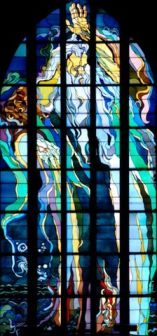
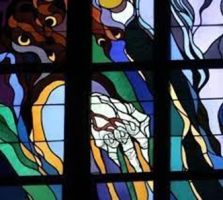
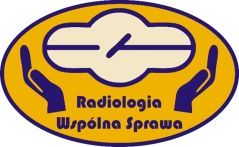
Conference entitled Radiology, a Common Cause (RWS)
This is an educational conference intended for radiographers (including student radiographers), specialists in medical physics and engineering as well as radiologists. Presentations during the event focus on some of the most interesting issues related to diagnostic imaging. Importantly, the conference also provides a platform for professionals representing various types of diagnostic imaging to share information and to build a community. In other words, those in attendance can learn a lot and they can discuss issues which are important for the community.
The event was conceived by Prof. Andrzej Urbanik, and for the first time was held in 2012. It was organised by the Chair of Radiology, at Collegium Medicum, Jagiellonian University for 5 years. Since 2017 it has been organised by the Radiology Association in Rzeszów.
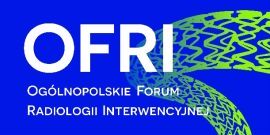
Polish Forum for Interventional Radiology (OFRI)
The forum, launched in 1995 by Prof. Andrzej Urbanik, originally was a regional event, but it soon became the most important educational conference intended for interventional radiologists in Poland. Until 2021 it was organised by the Chair of Radiology at Collegium Medicum, Jagielloniam University, and then by Interventional Radiology Unit of the Polish Medical Society of Radiology.
Radiology in the opinion of radiologists and medical professionals of other selected specialisations
The purpose of the pilot questionnaire survey was to asses the usefulness of radiology as well as the radiologists’ quality of work in medical procedures. For this purpose, the results of 1,151 questionnaires (out of 2,000 sent out) containing answers to 5 questions were analysed. They were filled in by physicians (specialists in surgery, internal medicine, family medicine and radiology) from eight provinces of Poland. The findings showed a high percentage of positive opinions about the usefulness of radiology in the medical process and a high percentage of positive opinions about radiologists’ work. The opinions expressed by family medicine specialists differed from those presented by other specialists.
Responses to the detailed questions:
- Do you regularly cooperate with a radiologist/medical professionals of other specialisations (question to radiologists)?
Internists 93% Surgeons 86% Family doctors 60% Radiologists 88%
- What is in your opinion the importance of radiological examinations (CT, MRI, X-ray, Ultrasound) in medicine?
High
Internists 95% Surgeons 84% Family doctors 90% Radiologists 98%
Low 0%
- What is the importance of radiologist's work in the treatment of your patients?
High + Moderate
Internists 100% Surgeons 96% Family doctors 45% Radiologists 65%
High
Internists 68% Surgeons 50% Family doctors 100% Radiologists Rad 98%
Low
Internists 0% Surgeons 4% Family doctors 0% Radiologists Rad 2%
- Are radiologists needed in hospitals 24 hours a day?
YES
Internists 98% Surgeons 92% Family doctors --- Radiologists 89%
- Do radiologists, in your opinion, produce sufficient descriptions of diagnostic examinations?
Yes, always
Internists 12% Surgeons 5% Family doctors 50% Radiologists 8%
Yes, generally
Internists 51% Surgeons 75% Family doctors 40% Radiologists 72%
Not always
Internists 32% Surgeons 18% Family doctors10% Radiologists 19%
No
Internists 5% Surgeons 2% Family doctors Rad 0% Radiologists 1%
The survey was carried out by the team consisting of Faustyna Świętoń and Małgorzata Król members of Radiographers Science Club (College of Medical Sciences, University of Rzeszów) as well as Małgorzata Tomera and Andrzej Urbanik (Chair of Radiology, Collegium Medicum, Jagiellonian University)


